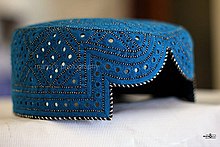Sindhi cap


The Sindhi cap, also known as the Sindhī ṭopī (Sindhi: سنڌى ٽوپى), is a skullcap worn predominantly by Sindhis in Sindh, Pakistan. Together with Ajrak or Saraiki Ajrak, the Sindhi cap is regarded as an essential part of Sindhi and Saraiki culture.[1][2]
History[]
In Sindhi culture, the Sindhi cap is often given as a gift or as a sign of respect,[2] along with the Ajrak. Hand-woven Sindhi topis are work of hard labour. It is usually celebrated on the first Sunday of every December. Sindhi topis are primarily produced in Tharparkar, Umerkot, Sanghar, Kandhkot, Larkana, Nawabshah, and some other districts of the Sindh.[3]
The Sindhi cap is especially celebrated on Sindhi Cultural Day[4] which was originally named Sindhi Topi Day.[2] In December 2009, Sindhi Topi Day was celebrated in Pakistan's Sindh province to celebrate the Sindhi cap, and Sindhi culture in general,[5] where the following year the day was renamed to Sindhi Cultural Day.

Description[]
The hat is circular/cylindrical except for a portion cut out in the front to expose the forehead the cut in the front is shaped like an arch. Intricate geometrical designs are embroidered on the hat, and very often small pieces of mirror and gemstones are sewed into it.

See also[]
- Culture of Sindh
- Sindhi Cultural Day
- Ajrak
References[]
- ^ "'Sindhi topi and Ajrak Day' the culture of Sindh". magtimes.com. Archived from the original on 2013-11-04. Retrieved 2013-11-01. Origins of Sindhi Topi
- ^ a b c "Sindh celebrates Sindh Culture Day". The Express Tribune. 2010-12-04. Retrieved 2021-04-09.
- ^ "Topi Day Coverage". dawn.com.
- ^ "Sindhi culture day". nation.com.pk. 2018-12-13. Retrieved 2021-04-09.
- ^ "Sindh celebrates first ever 'Sindhi Topi Day'". dawn.com. 2009-12-06. Retrieved 2021-04-09.
External links[]
| Wikimedia Commons has media related to Sindhi topi. |
- Pakistani headgear
- Pakistani clothing
- Sindhi culture
- Caps
